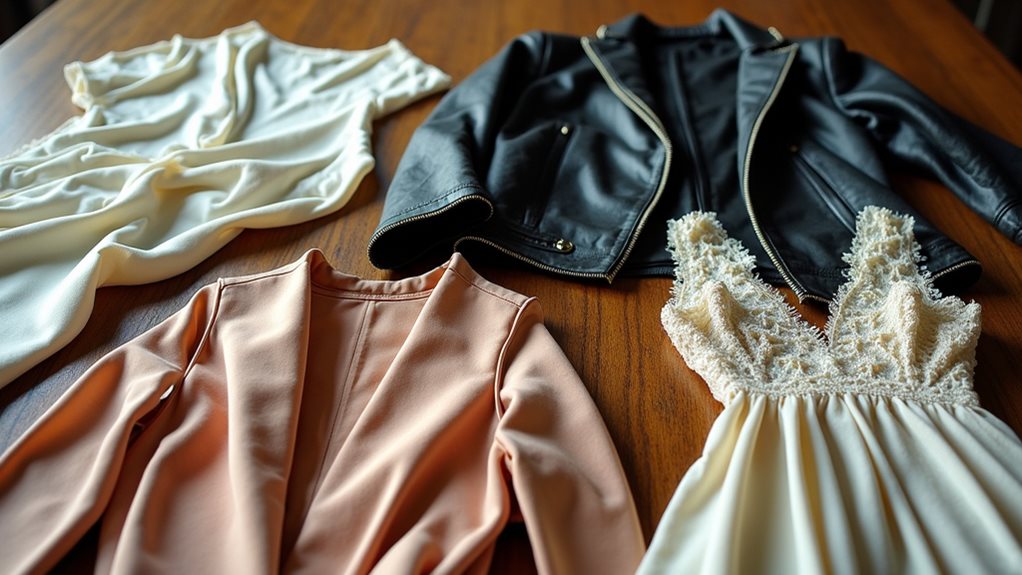Your dry cleaning timeline depends on what you’re dropping off and where you’re taking it. Standard items like dress shirts and pants typically return in 1-2 days, while delicate fabrics need 3-4 days for careful handling. Formal suits require 3-5 days, and wedding dresses can take anywhere from 3 days to 2 weeks for preservation. Home kits offer instant gratification at 30-60 minutes, though they won’t match professional quality for intricate pieces that need specialized attention.
Understanding the Dry Cleaning Process and Timeline Factors
When you’re standing at the dry cleaner’s counter, clutching that favorite blazer you spilled coffee on during yesterday’s important meeting, you’re probably wondering how long you’ll be separated from your beloved garment.
The truth is, dry cleaning takes different amounts of time depending on what you’re dropping off and how busy your cleaner happens to be.
Standard clothing items like dress shirts and pants typically have a turnaround time of one to two days, while delicate garments require additional time for careful handling.
Your wedding dress deserves special attention during the cleaning process, often taking weeks for proper preservation.
Heavily soiled clothes need extra treatment cycles, and most cleaning services maintain a holding period for uncollected items—so don’t forget to pick up your freshly cleaned favorites! 📅
Many dry cleaners offer expedited service for an additional fee when you need garments returned the same day or next day for urgent situations.
Turnaround Times by Garment Type and Fabric

You’ve probably noticed that your favorite cotton dress shirt comes back from the cleaners much faster than that beaded evening gown you wore to your cousin’s wedding, and there’s actually a pretty logical reason for this timing difference.
Standard items like everyday shirts, blouses, and trousers typically follow a predictable 1-2 day schedule since they’re made from sturdy fabrics that can handle the regular cleaning cycle without much fuss.
However, when you’re dealing with delicate silks, intricate beadwork, or specialty items like formal suits and wedding dresses, you’re looking at anywhere from 3 days to several weeks, depending on how much TLC your garment needs to come back looking absolutely perfect 👗.
Additionally, certain stains or damage may extend the cleaning process beyond the standard timeframe since they require specialized treatment to properly remove without harming the fabric.
Standard Clothing Processing Times
Five different garment types can mean five completely different timelines at your local dry cleaner, and honestly, I learned this the hard way when I dropped off my entire wardrobe the day before an important business trip 😅.
Standard clothing items like dress shirts and trousers typically have the fastest turnaround time at just 1-2 days, making them perfect for last-minute cleaning emergencies.
However, delicate garments with intricate fabrics require 3-4 days of careful processing times to protect those beautiful embellishments you paid extra for.
Formal suits need 3-5 days because of their custom construction, while wedding dresses can take weeks due to their preservation needs and thorough cleaning requirements.
Understanding these cleaning times helps you plan better than my frantic, pre-flight wardrobe crisis.
Many dry cleaners offer same-day service for an additional fee, though this expedited option may not be suitable for all fabric types or complex stain removal processes.
Delicate Fabric Requirements
Silk blouses and chiffon scarves taught me that delicate fabrics operate on their own timeline, one that doesn’t care about your weekend plans or that Monday morning presentation.
These finicky materials demand special care, requiring 3-4 days minimum for proper dry cleaning time. Your wedding dress with its intricate designs and heavy embellishments? That’s looking at anywhere from 3 days to 2 weeks, depending on complexity.
Formal suits made from delicate fabrics need 3-5 days for thorough cleaning without compromising fabric integrity.
Don’t even get me started on comforters – those oversized beauties can take up to a week because they require specialized equipment.
The actual processing time depends on factors such as fabric complexity, stain severity, and the dry cleaner’s workload and equipment capacity.
The lesson I’ve learned? Factor these extended turnaround times into your planning, because rushing delicate items never ends well 😅.
Specialty Garment Considerations
While delicate fabrics set their own demanding schedule, different garment types add another layer of complexity to the dry cleaning timeline, something I discovered when I tried to get my entire formal wardrobe cleaned for back-to-back events.
Your specialty garments each demand their own unique turnaround schedule, and understanding these differences helps you plan accordingly.
Here’s what you can expect from different garment types:
- Intricate dresses and embellished clothing – 3-4 days minimum for careful handling
- Formal suits and tuxedos – 3-5 days due to multiple components requiring attention
- Wedding dress cleaning and preservation – 3 days to 2 weeks depending on fabric type
- Large bedding items – Up to one week for thorough processing
- Standard shirts and trousers – 1-2 days for quickest service
Heavily stained garments may require special treatment that extends the cleaning process to 5-7 days or longer depending on the severity and type of stain.
Pro tip: always ask your dry cleaners about specific cleaning time estimates upfront!
Home Dry Cleaning Kit Processing Times

When you’re tired of waiting days for professional dry cleaning and decide to try a home kit, you’ll discover the entire process takes just 30 minutes to an hour, which honestly feels like a small miracle compared to traditional turnaround times.
The beauty of DIY dry cleaning lies in breaking down each step—from pre-treating those stubborn wine stains (we’ve all been there 😅) to loading your garments with cleaning sheets, then letting your dryer work its magic for about 30-60 minutes while you catch up on Netflix.
Understanding these timeframes helps you plan your cleaning routine effectively, especially when you compare the immediate convenience of home kits against the thorough, professional results you’d get from your neighborhood cleaner.
Home dry cleaning kits work particularly well for delicate fabrics like silk and wool that would otherwise require professional chemical solvent treatment.
Kit Processing Duration
Since you’re exploring the DIY route, you’ll find that home dry cleaning kits offer a surprisingly quick turnaround that puts you in complete control of the timeline.
When I first tried these kits, I was amazed at how the entire DIY dry cleaning process wrapped up in just 30 minutes to an hour—much faster than waiting days for professional dry cleaning services.
Here’s what you can expect during kit processing duration:
- Pre-treatment phase: 5-10 minutes for stain preparation
- Tumble drying cycle: 30-60 minutes with cleaning sheets
- Post-treatment waiting: 5-10 minutes for agent dissipation
- Total timeline: 30 minutes to 1 hour complete process
- Convenience factor: No appointment scheduling or pickup delays
While effectiveness mightn’t match professional services, you’ll appreciate having freshly cleaned garments ready immediately. Before using any home dry cleaning kit, always test the method on an inconspicuous area first to ensure the fabric care labels and cleaning process are compatible with your specific garment.
Step-by-Step Time Breakdown
Breaking down the home dry cleaning process into specific time segments helps you plan your schedule more effectively, especially when you’re juggling multiple household tasks or need that favorite blazer ready for tomorrow’s meeting.
Pre-treatment of visible stains takes just a few minutes, though I’ve learned not to rush this step after missing a stubborn coffee spot once.
Loading your garments into the bag with the cleaning sheet requires about five minutes, then comes the main event: tumble drying for thirty minutes to an hour, depending on how many pieces you’re cleaning.
The post-treatment waiting period lasts ten to fifteen minutes, giving those cleaning agents time to dissipate completely.
Before starting any home dry cleaning process, always check garment care labels to ensure the item is suitable for at-home treatment rather than professional dry cleaning.
DIY Vs Professional
Although home dry cleaning kits promise convenience with their thirty-minute to one-hour turnaround times, the reality is that choosing between DIY and professional services involves weighing speed against quality in ways I didn’t fully appreciate until I ruined my favorite silk blouse.
You’ll discover that DIY methods offer immediate satisfaction, but professional dry cleaning delivers superior cleaning results, especially for delicate fabrics and stubborn stains.
Here’s what you should consider when comparing these options:
- Turnaround time: Home dry cleaning kits complete the cleaning process in 30-60 minutes versus 1-2 days for dry cleaning services
- Stain treatment: Pre-treating visible stains adds several minutes to your DIY timeline
- Garment complexity: Professional cleaners handle intricate designs and heavily soiled items more effectively
- Multiple treatments: Home kits often require repeated cleaning cycles for challenging stains
- Quality assurance: Professional services guarantee better results for expensive or sentimental garments 🧥
For urgent situations, many modern dry cleaners now offer same-day service through streamlined processes and dedicated express lanes, though this convenience typically comes with premium pricing.
Common Delays That Extend Processing Times

While you might expect your dry cleaning to follow a predictable timeline, several common delays can throw a wrench into even the most carefully planned schedule, and I’ve learned this lesson the hard way more times than I’d care to admit.
During busy periods like holidays or local events, cleaners face overwhelming demand that stretches processing times beyond their usual promises. Your garments might need additional treatments if they’re heavily soiled, while complex garments with intricate designs require specialized attention that simply takes longer.
I’ve also discovered that dropping clothes off during peak evening hours, when limited staff juggle countless orders, rarely leads to timely service – a mistake that once left me scrambling for an outfit before an important meeting! 😅
Additionally, specialty items like wedding dresses or leather goods naturally require extended processing periods of 5-7 days or more due to their delicate nature and specialized cleaning requirements.
Items That Cannot Be Dry Cleaned

- Fur and suede – These require specialized cleaning methods to prevent irreversible damage.
- Leather garments – Need specific treatments designed for their unique properties.
- Heavily beaded items – Intricate embellishments often break during processing.
- Certain delicate fabrics – Some materials can’t withstand harsh chemicals and should be hand washed instead.
- Mislabeled “dry clean only” pieces – Always double-check garment labels for accuracy.
Proper Storage Methods for Dry Cleaned Garments

After you’ve invested time and money into professional dry cleaning, the last thing you want is to watch your freshly cleaned garments deteriorate in storage, which unfortunately happens more often than most people realize.
I learned this lesson the hard way when my favorite wool blazer developed mysterious white spots after months in a plastic garment bag 😅.
Your dry cleaners did their part perfectly, but now it’s your turn to safeguard that investment.
Always verify garments are fully dry before storing them in breathable cotton or linen covers—never those tempting plastic covers that trap moisture and invite mildew.
Invest in sturdy, padded hangers to maintain shape, and choose a cool, dry storage spot away from sunlight to prevent damage and fading.




